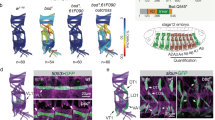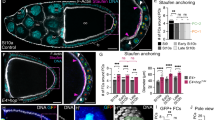Abstract
THE genes torso (tor)1 and torso-like(tsl)2 are two of the Drosophila maternal group genes implicated in a receptor tyrosine kinase signalling pathway that specifies terminal cell fate (reviewed in ref. 3). Loss-of-function mutations in these loci cause an identical phenotype in which pattern elements from the anterior (acron) and posterior (telson) ends have been deleted. We have cloned the tsl gene and demonstrate here that, in agreement with previous genetic data, it encodes a protein that is secreted and whose transcription is restricted to specialized categories of follicle cells localized at the poles of the egg chamber. At early blastoderm stage, tsl protein forms a symmetrical concentration gradient at the poles on the surface of the devitellinized embryo. Unrestricted expression of the tsl protein in tsl female mutants induces terminal pattern elements and suppresses the formation of abdomen in embryos. These results suggest that the tsl protein is the ligand that binds to the torso receptor.
This is a preview of subscription content, access via your institution
Access options
Subscribe to this journal
Receive 51 print issues and online access
$199.00 per year
only $3.90 per issue
Buy this article
- Purchase on Springer Link
- Instant access to full article PDF
Prices may be subject to local taxes which are calculated during checkout
Similar content being viewed by others
References
Schüpabch, T. & Wieschaus, E. Wilhem Roux Arch. dev. Biol. 195, 302–317 (1986).
Nüsslein-Volhard, C., Frohnhöfer, H. G. & Lehmann, R. Science 238, 1675–1681 (1987).
Nüsslein-Volhard, C. Development 1, 1–10 (1991).
Sprenger, F., Stevens, L. M. & Nüsslein-Volhard, C. Nature 338, 478–483 (1989).
Casanova, J. & Struhl, G. Genes Dev. 3, 2025–2038 (1989).
Sprenger, F. & Nüsslein-Volhard, C. Cell 71, 987–1001 (1993).
Casanova, J. & Struhl, G. Nature 362, 152–155 (1993).
Stevens, L. M., Frohnhöfer, H. G., Klinger, M. & Nüsslein-Volhard, C. Nature 346, 660–663 (1990).
Tautz, D. & Pfeiffle, C. Chromosoma 98, 81–85 (1989).
King, R. C. Ovarian Development in Drosophila melanogaster (Academic, New York, 1970).
Steinhauser, W. R., Walsh, R. C. & Kalfayan, L. Molec. cell. Biol. 9, 5726–5732 (1989).
Cavener, D. R. Nucleic Acids Res. 15, 1353–1361 (1987).
Von Heije, G. Nucleic Acids Res. 14, 4683–4690 (1986).
Van der Meer, J. Drosoph. Inf. Serv. 52, 160 (1977).
Campos-Ortega, J. A. & Hartenstein, V. in The Embryonic Development of Drosophila melanogaster (Springer, Berlin, 1985).
Degelmann, A., Hardy, P. A., Perrimon, N. & Mahowald, A. P. Devl Biol. 115, 479–489 (1986).
Perrimon, N., Mohler, D., Engstrom, L. & Mahowald, A. P. Genetics 113, 695–712 (1986).
Robertson, H. M. Genetics 118, 461–470 (1988).
Roberts, D. B. Drosophila, A Practical Approach (IRL Oxford, 1986).
Anderson, K. & Nüsslein-Volhard, C. Nature 331, 223–237 (1984).
Thummel, C. S., Boulet, A., M. & Lipshitz, H. D. Genes 74, 445–456 (1988).
Maniatis, T., Fritsch, E. F. & Sambrook, J. Molecular Cloning: A Laboratory Manual (Cold Spring Harbor Laboratory, New York, 1982).
Rijsewijk, F. et al. Cell 50, 649–657 (1987).
Kyte, J. & Doolittle, R. F. J. molec. Biol. 157, 105–132 (1982).
Ashburner, M. Drosophila: A Laboratory Handbook (Cold Spring Harbor Laboratory Press, New York, 1989).
Author information
Authors and Affiliations
Rights and permissions
About this article
Cite this article
Martin, JR., Raibaud, A. & Ollo, R. Terminal pattern elements in Drosophila embryo induced by the torso-like protein. Nature 367, 741–745 (1994). https://doi.org/10.1038/367741a0
Received:
Accepted:
Issue Date:
DOI: https://doi.org/10.1038/367741a0
This article is cited by
-
Perforin-2 clockwise hand-over-hand pre-pore to pore transition mechanism
Nature Communications (2022)
-
Comparative RNA-sequencing analysis of ER-based HSP90 functions and signal pathways in Tribolium castaneum
Cell Stress and Chaperones (2018)
-
Torso-like mediates extracellular accumulation of Furin-cleaved Trunk to pattern the Drosophila embryo termini
Nature Communications (2015)
-
Trunk cleavage is essential for Drosophila terminal patterning and can occur independently of Torso-like
Nature Communications (2014)
-
The pea aphid uses a version of the terminal system during oviparous, but not viviparous, development
EvoDevo (2013)
Comments
By submitting a comment you agree to abide by our Terms and Community Guidelines. If you find something abusive or that does not comply with our terms or guidelines please flag it as inappropriate.



